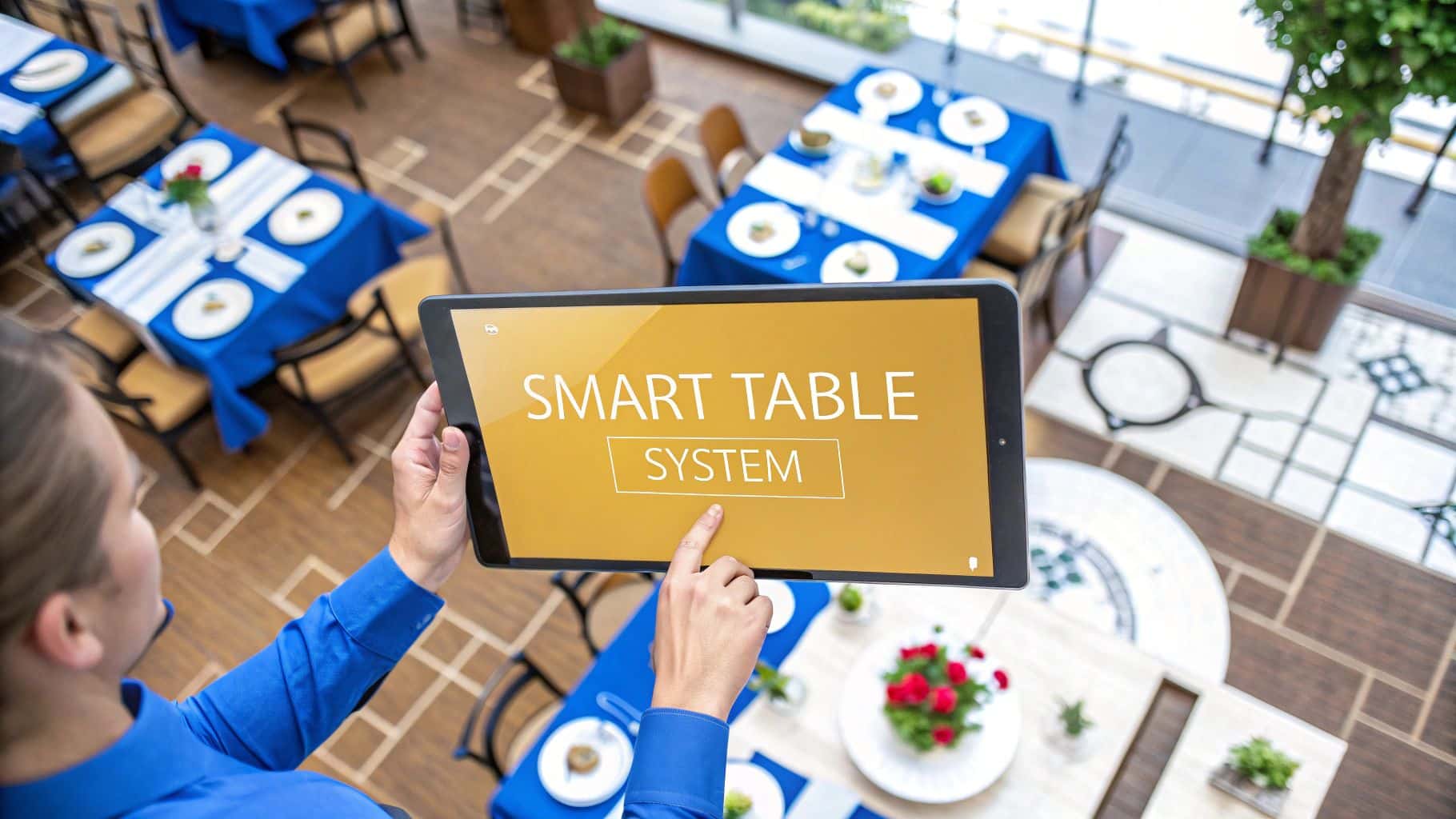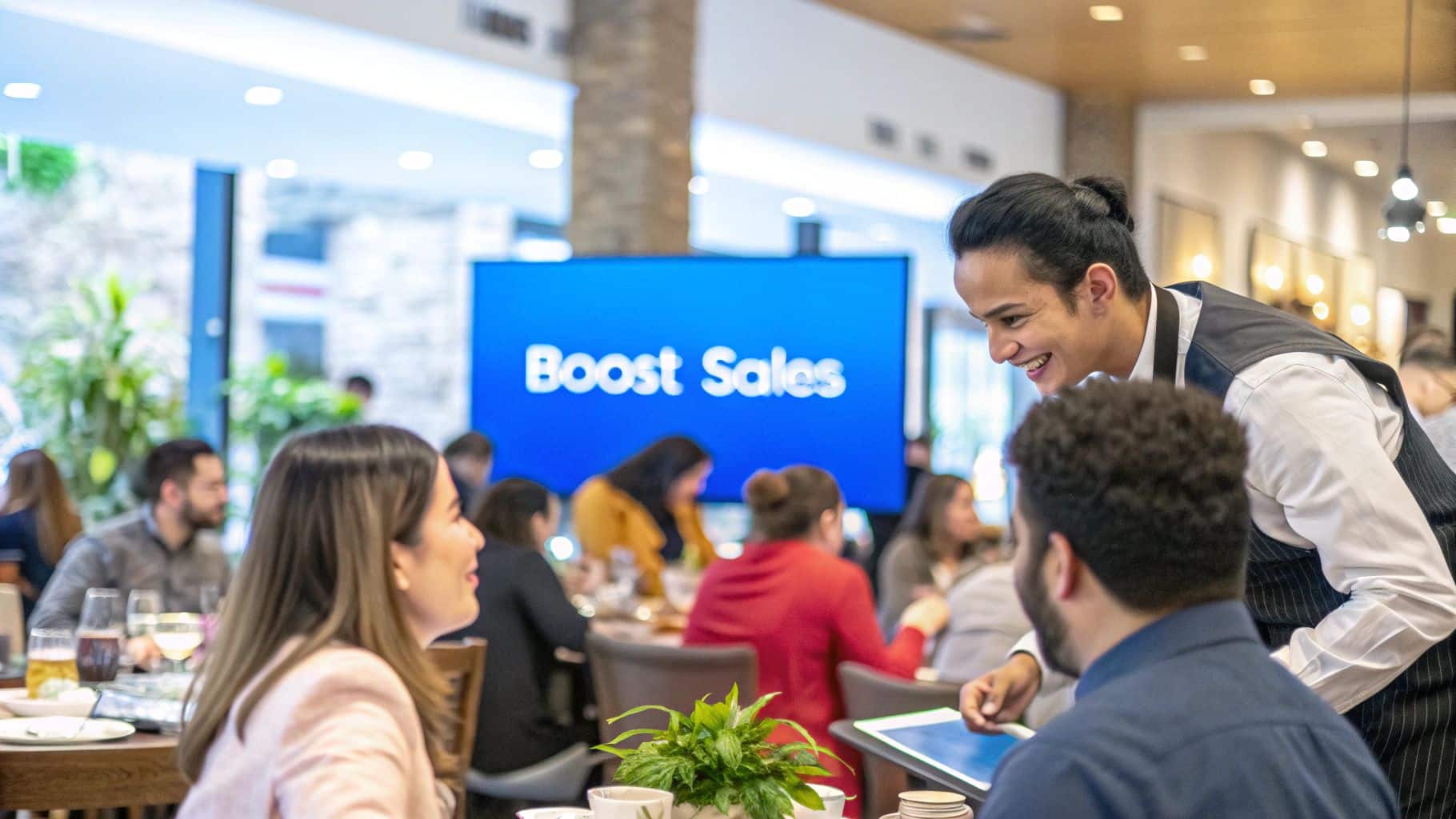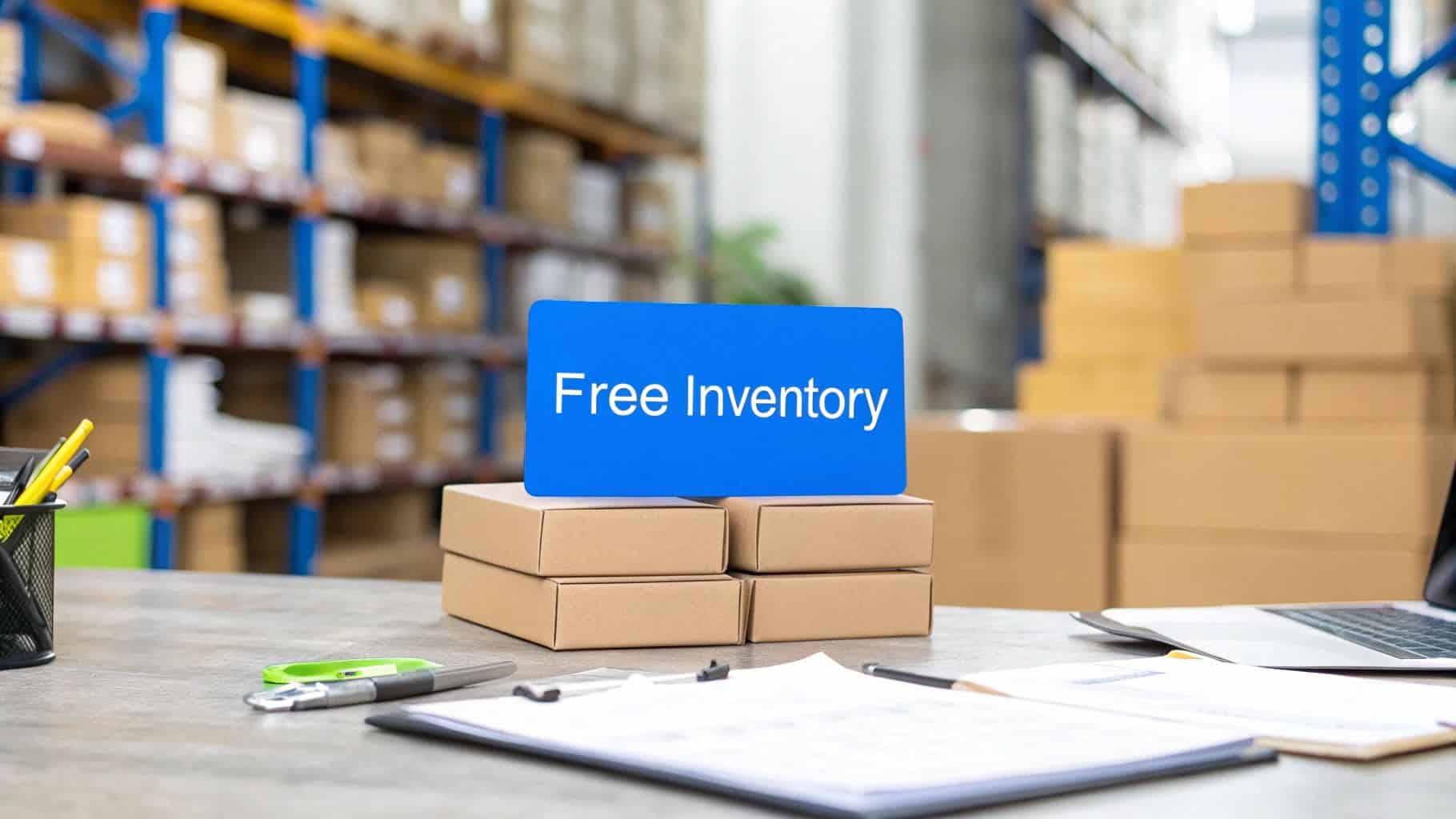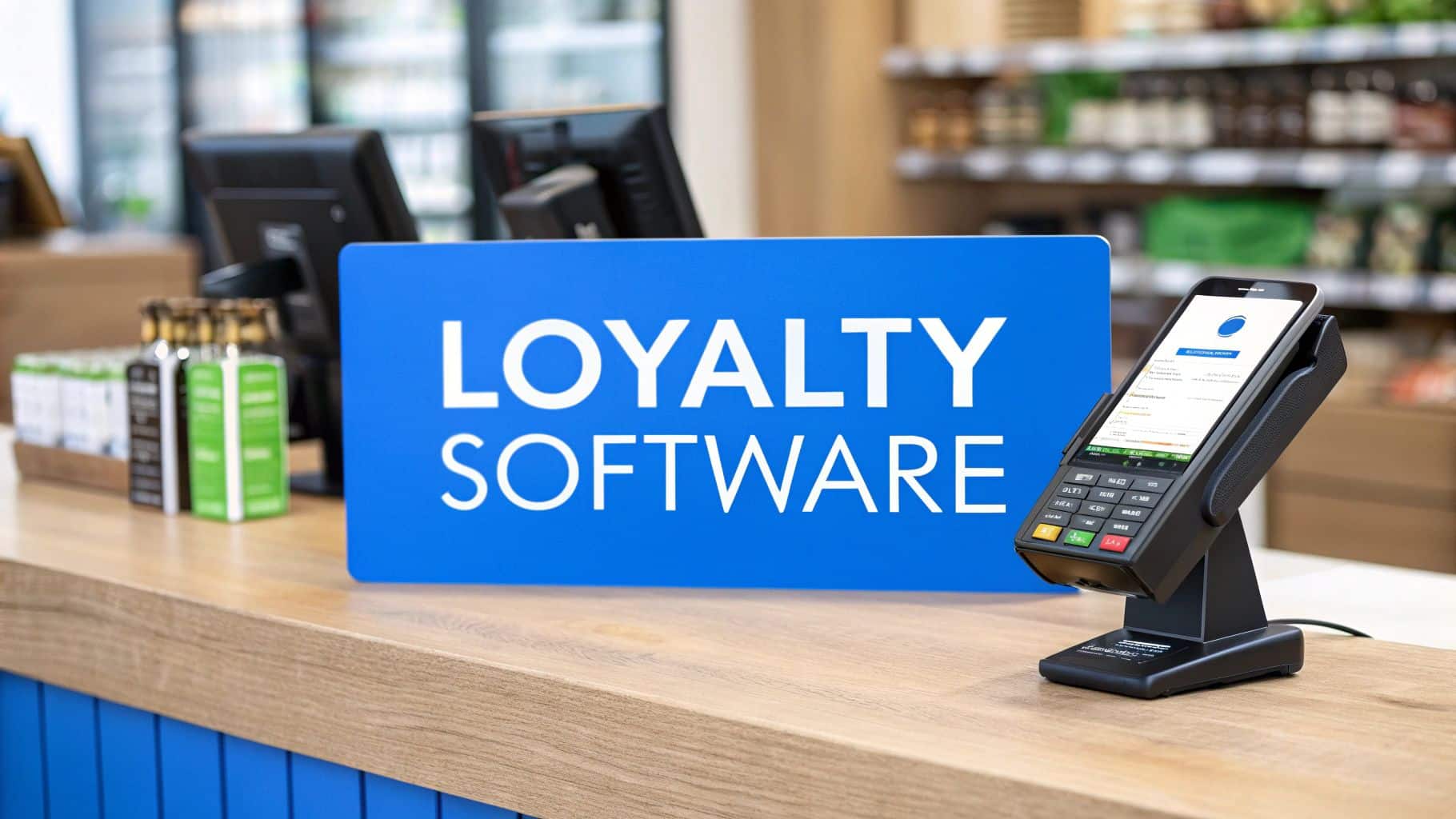Think of a restaurant table management system as the ultimate air traffic controller for your dining room. It’s a digital tool designed to orchestrate the constant flow of guests, reservations, and tables. The goal? To boost efficiency, slash wait times, and create a far better experience for everyone who walks through your door. This isn't just a digital version of a floor chart—it's the new operational command center for your entire front-of-house team.
Unlocking a More Organized Dining Room

Picture the dinner rush on a Saturday night. Without a system, the host stand is a flurry of activity—a scribbled waitlist, ringing phones, and a desperate search for an open table. This manual juggling act almost always results in long waits, unhappy guests, and tables sitting empty for far too long. A restaurant table management system completely changes this dynamic.
It puts a real-time, digital map of your floor plan right at your team's fingertips. At a glance, they can see which tables are occupied, which are being bussed, and which are ready to go. This kind of instant clarity takes all the guesswork out of seating, empowering your staff to make smarter decisions in a fraction of the time.
From Chaos to Coordinated Control
A good system goes way beyond just tracking tables; it helps you guide the entire guest journey. It organizes incoming reservations and intelligently manages the waitlist, even sending guests an SMS with an accurate wait time. That one feature can be a lifesaver, dramatically cutting down on the number of people who get frustrated and leave.
Instead of a frantic scramble, you get a smooth, controlled flow. The system helps you turn tables faster, making sure every seat is earning money for you as much as possible. This level of coordination is what creates a calm, professional atmosphere, even when you're completely slammed.
The Core of Modern Restaurant Operations
At its heart, table management is all about replacing gut feelings with good data. By digitizing your floor plan and waitlist, you create a single source of truth that keeps your entire team in sync. It's especially powerful when connected with your other core software. You can learn more about how it all fits together in our guide to choosing a restaurant point of sale system.
A powerful system doesn't just manage tables; it manages expectations. By providing accurate wait times and a fair process, you turn a potentially negative waiting experience into a positive first impression.
The table below breaks down the shift from common restaurant headaches to the elegant solutions a table management system offers.
| Common Restaurant Chaos | The Organized System Solution |
|---|---|
| Inaccurate wait time quotes | Automated, data-driven wait time estimates |
| High guest walk-away rates | SMS notifications to keep guests engaged |
| Tables sitting empty and unnoticed | Real-time floor plan with table status updates |
| Inefficient staff communication | A centralized dashboard for the entire team |
| Overbooking or double-booking tables | Synchronized reservation and waitlist management |
Core Features Every Modern System Should Have
When you're looking into a restaurant table management system, it’s easy to get bogged down in a long list of functions. But let's cut through the noise. There are a handful of core features that are truly non-negotiable for any modern spot. These aren't just bells and whistles; they’re the foundational tools that directly impact your efficiency, your staff's sanity, and the experience your guests have from the moment they walk in.
Think of these features as the essential parts of a high-performance engine. Without them, your whole operation is going to sputter and stall during a busy service. The first and most critical component? A dynamic, visual floor plan.
Visual Floor Plan and Real-Time Status
A static drawing of your layout just doesn't cut it anymore. A top-tier system gives you a live, interactive map of your dining room. This digital floor plan should be an exact mirror of your actual setup, letting your host and servers see the status of every single table with a quick glance.
This is usually done with simple color-coding and clear icons. Green might mean a table is open, yellow means the party is seated, orange means entrees are out, and red means it's ready to be bussed. This kind of instant visual communication gets rid of the need for hosts to shout across the room to servers, creating a much calmer, more organized atmosphere.
With this level of clarity, your team can turn tables far more efficiently and truly maximize your restaurant's capacity, even on the busiest nights.
A study on restaurant customer behavior revealed that cutting down wait times can lead to a 15% increase in monthly revenue. The power to see available tables instantly is the first step to making that happen.
This real-time overview empowers your team to act decisively. It turns a chaotic Saturday night rush into a smoothly managed, profitable service. It’s the difference between guessing where to seat the next party and knowing with absolute certainty.
To help you see the bigger picture, here's a quick breakdown of the features you should be looking for and why they matter so much.
Essential Features of a Table Management System
| Feature | Operational Benefit | Guest Experience Impact |
|---|---|---|
| Visual Floor Plan | Staff can see table statuses instantly, reducing communication errors and speeding up seating decisions. | Faster seating and a calmer dining environment create a positive first impression. |
| Smart Waitlist | Provides accurate, data-driven wait time quotes and automates guest notifications via SMS. | Guests feel informed and respected, and they can wait comfortably without crowding the entrance. |
| Reservation Management | Centralizes all bookings (phone, web, apps) to prevent overbooking and streamline party planning. | A seamless, error-free booking process builds trust and reduces pre-arrival frustration. |
| Guest Database (CRM) | Tracks visit history, preferences, and special occasions to inform both service and marketing. | Personalized greetings and proactive service (like offering a favorite table) create loyal regulars. |
| Performance Analytics | Delivers hard data on table turn times, server performance, and peak hours for better staffing. | A consistently well-staffed and efficient floor means better, more attentive service for everyone. |
These core functions work together to create a system that’s much more than the sum of its parts, touching every aspect of your operation.
Smart Waitlist and Reservation Management
The next essential feature set is all about managing the flow of guests before they even sit down. A powerful restaurant table management system throws out the old clipboard and paper waitlist for an intelligent, automated tool. Your staff should be able to add guests, quote accurate wait times based on actual table turnover, and automatically send an SMS text when their table is ready.
This simple function has a massive impact. It frees guests from hovering by the host stand, which cuts down on congestion and makes their initial experience so much better. For reservations, the system should pull all your bookings—whether they come from your website, a phone call, or a third-party app—into one central place to prevent those costly double-booking mistakes.
Key capabilities to look for include:
- Automated Wait Time Quotes: The system does the math for you, calculating realistic wait times based on live data, not just a gut feeling.
- Two-Way SMS Communication: This lets guests confirm or cancel right from their phone, keeping your waitlist up-to-the-minute accurate.
- Reservation Reminders: An automatic reminder sent to guests can significantly reduce your no-show rate.
These tools create a process that’s both fair and transparent. When guests feel they’re being treated fairly and are kept in the loop, their perception of the wait completely changes from a negative to just a manageable part of the dining experience.
Guest Database and Analytics
Finally, a truly great system does more than just manage what's happening right now; it helps you plan for the future. A built-in guest database, often called a Customer Relationship Management (CRM) feature, is an absolute goldmine of information. It can track a guest's visit history, seating preferences, special occasions like birthdays, and even their favorite dishes.
Imagine a regular customer walking in and being greeted by name and led to their favorite corner table without even having to ask. That’s the kind of personalized service that builds powerful, lasting loyalty.
This data also fuels smarter operational insights. You can pinpoint your peak dining times with precision, which helps you nail your staffing levels every shift. By analyzing how long certain parties stay, you can fine-tune your service steps or even explore new tech. As you can see in our guide on the benefits of self-ordering kiosks in restaurants, understanding diner behavior is the key to introducing technology that actually speeds up service without feeling impersonal. This data-driven approach moves you from constantly putting out fires to proactively building a better, more successful restaurant.
The Real-World Payoff: What an Upgraded System Actually Does for Your Restaurant
Forget the technical jargon for a moment. Let's talk about what a restaurant table management system actually does for your business day-in and day-out. This isn't just about getting new software; it's a strategic move that shows up directly on your bottom line. The biggest and most immediate win? You’ll turn tables faster, which means you can serve more guests and make more money.
Think about the classic dinner rush chaos. A table sits empty for ten agonizing minutes simply because the host is juggling a waitlist and doesn't know it's been cleared. A smart system closes that gap instantly. Your team gets live updates, seating the next party the second a table is ready. That ten minutes of dead time just turned into another round of drinks and appetizers sold.
Squeeze More Revenue from Your Floor Plan
Every chair in your dining room is a potential revenue source. A table management system is like having a master strategist on your team, helping your host make the smartest seating choice every single time. It prevents the all-too-common mistake of seating a couple at a four-top during a rush, saving those larger tables for the bigger groups that are sure to walk in.
This kind of smart allocation is crucial. It means you can serve more people during your peak hours without having to knock down a wall to add more space. In fact, one study on restaurant customer behavior found that just cutting down on wait times can boost monthly revenue by 15%. Getting people seated faster and more efficiently is the first, most critical step.
You're not just filling seats; you're maximizing the potential of the space you already have. That efficiency flows straight to your sales and profit margins, giving you a clear, financial return on the investment.
A table management system turns your static floor plan into a dynamic, money-making machine. It’s about making sure no seat stays empty and no sale is missed. That’s operational efficiency in a nutshell.
This push for efficiency is exactly why restaurant tech is booming. The market for restaurant management software hit USD 5.41 billion in 2024 and is expected to grow at a blistering 15.7% each year through 2032. Restaurants everywhere are realizing the power of cloud-based platforms to run their entire show from one place. If you're curious, you can explore more data on this industry growth and see just how big this shift is.
Get Your Staff on the Same Page
A central restaurant table management system acts as the single source of truth for your front-of-house team, tearing down the communication walls that cause so many headaches and mistakes. When everyone is looking at the same live map of the dining room, the entire service just flows better.
Here’s what that looks like in practice:
- No More Guesswork: Hosts see a table is clean and ready to go without having to walk the floor or ask a busy server.
- Seamless Handoffs: A server gets an instant notification that a new party has just been seated in their section, so they can greet them right away.
- Faster Flips: The system can automatically ping a busser the moment a table pays their check, kicking off the clearing and cleaning process immediately.
This kind of synchronized workflow takes a massive amount of stress off your staff. They can stop running around trying to get information and start focusing on what they do best: taking care of your guests. The whole vibe of the restaurant becomes calmer and more organized.
Create Happier Guests Who Keep Coming Back
At the end of the day, a well-run restaurant creates happy customers. It all starts at the host stand. Instead of giving a wild guess for the wait time, your host can provide a precise, data-backed estimate. This manages expectations from the get-go and dramatically cuts down on the number of people who get frustrated and leave.
That great experience doesn't stop once they're seated. With your team communicating effortlessly, service is faster and more attentive. Guests feel looked after, not forgotten. A smooth, positive dining experience is what converts a first-time visitor into a regular, and even better, into someone who tells their friends about your place. That cycle of happy guests is the ultimate reward for getting your system right.
Integrating Table Management with Your POS
Having a standalone table management tool is a great first step, but the real game-changer is hooking it directly into your Point of Sale (POS) system. It’s like the difference between having a paper map and a live GPS. The map is useful, sure, but the GPS guides your every move with real-time, interconnected data.
This connection builds a seamless bridge between your front-of-house and back-of-house, syncing guest seating with order entry and payments. It closes the communication gaps that inevitably lead to mistakes and bottlenecks during a hectic dinner rush. When these two systems are in constant communication, your entire workflow becomes smarter and more fluid.
Creating a Single Source of Truth
Picture this: your host seats a party of four at Table 12 using the restaurant table management system. In that exact moment, Table 12 flags as "occupied" on every server's POS terminal, ready for an order to be punched in.
No more shouting across a noisy dining room. No more servers awkwardly approaching a table that isn't in their section. This immediate sync eliminates costly errors, like two servers trying to take an order from the same guests or, worse, a table getting completely forgotten during the rush. It establishes one reliable version of reality that your entire team can trust, from greeting to goodbye.
By unifying table and order management, you elevate your POS from a simple payment machine to the central nervous system of your restaurant. Every action, from seating to sale, is connected in one logical, efficient flow.
This synergy doesn't just speed things up; it also unlocks a goldmine of data you couldn't get otherwise.
Unlocking Powerful Operational Insights
When your table data talks to your sales data, you get a much clearer picture of your restaurant’s health. An integrated system automatically tracks key metrics that show you exactly how well your dining room is performing.
Suddenly, you have concrete answers to critical questions:
- What’s our average table turn time on a Friday night compared to a Tuesday? This helps you set realistic wait times and fine-tune your reservation strategy.
- Which servers generate the highest sales per table? You can spot your top performers and identify opportunities for staff training.
- How much revenue does each table generate per hour? This helps you pinpoint your most valuable real estate and inform future floor plan designs.
This information is all right there in one place, letting you spot trends and fix inefficiencies on the fly. You can start making decisions based on hard data, not just gut feelings. It's this kind of insight that's driving the POS restaurant management systems market toward a projected USD 56.9 billion by 2035. As you can see when you discover more insights about POS restaurant management system market growth, smart restaurants are investing in these unified solutions to stay ahead.
The Biyo POS Advantage
A platform like Biyo POS was built from the ground up with this kind of integration in mind. It's not just a payment processor with a few bells and whistles; it’s a full-blown command center for your restaurant. The table management feature isn’t some clunky add-on—it’s a core part of the ecosystem, designed to work flawlessly with ordering, kitchen displays, and analytics.
This all-in-one design is a massive benefit for any restaurant, especially those juggling multiple locations. To see how a unified system tames that complexity, check out our guide on how to master multi-location restaurant POS with table management. By choosing a truly integrated solution, you ensure every piece of your tech stack is pulling in the same direction, creating a smoother shift for your staff and an unforgettable experience for your guests.
How to Choose the Right System for Your Restaurant
Picking a restaurant table management system is one of those big decisions that can either make your life easier or create daily headaches for years. It’s not about finding software with a million bells and whistles; it's about finding the right one that solves your specific problems. The best way to do that is with a clear, step-by-step approach that ensures you get a tool your team and your guests will actually love.
The first step is to get brutally honest with yourself. Where are the bottlenecks in your service? Are your hosts drowning in a messy paper waitlist? Do you see clean tables sitting empty for 10 minutes too long between guests? When you identify these specific pain points, you’re not just vaguely shopping for software anymore—you’re on a mission to find a solution.
Define Your Restaurant's Unique Needs
Every restaurant has its own rhythm, and your system needs to match it. A chaotic, high-turnover brunch spot has completely different needs than a quiet, reservation-driven fine dining restaurant. Before you even start looking at demos, map out exactly what you need.
Think about these key factors:
- Size and Layout: How complicated is your floor plan? Do you need to manage a main dining room, a patio, and a bar area all at once?
- Service Style: A counter-service cafe needs pure speed. A full-service restaurant needs detailed table statuses, server assignments, and turn-time tracking.
- Tech Savviness: How comfortable is your staff with new technology? An intuitive interface is non-negotiable. If it isn't simple, it won't get used properly during a hectic rush.
- Guest Flow: Are you mostly walk-ins, or do you live and die by reservations? Your system should be built around how your customers find you.
Answering these questions gives you a solid profile of the perfect system, making it way easier to weed out the ones that just won't work.
Create a Vendor Evaluation Framework
Once you know what you’re looking for, it’s time to start sizing up the options. Don't get distracted by a slick sales pitch; stick to a structured plan. Start by making a shortlist of three to five vendors that seem like they could be a good match for your needs.
Next, book a live demo with each of them. This is your chance to see the software in a real-world context. A generic YouTube video won’t cut it—ask them to walk you through a scenario that mimics a typical Tuesday night at your restaurant. As you watch, pay close attention to how easy it is to use. If it feels clunky to you now, imagine how it’ll feel to your staff on a slammed Saturday.
A system that’s powerful but impossible to use creates more problems than it solves. Always prioritize an intuitive design and a simple interface—your team will thank you for it.
Finally, think about the future. Will this system grow with you? The solution you choose today needs to handle your business tomorrow, whether that means opening a new location or just getting busier. This is especially true in a market that's expanding so quickly. The restaurant management software space was valued at USD 5.79 billion in 2024 and is expected to reach USD 14.7 billion by 2030. A huge chunk of that growth—over 54%—is coming from cloud-based systems that can scale up easily. You can read the full research on restaurant software market trends to see just how critical this is.
Don’t Overlook Support and Reliability
Even the absolute best software glitches sometimes. The real difference between a good provider and a great one is what happens when things go wrong. Before you sign anything, dig into their customer support. Is it available 24/7? When you call, do you get a real person who understands restaurants, or are you stuck fighting with a chatbot? Think of great support as your insurance policy—it’s what keeps a small tech issue from tanking a whole night’s service.
Got Questions About Table Management Systems? We've Got Answers.
Bringing a new piece of technology into the heart of your restaurant is a big decision. It’s only natural to have questions about the cost, the impact on your team, and how it will all work on a busy Friday night. We hear the same handful of questions from restaurant owners all the time, so we’ve gathered them here to give you straight, clear answers.
Our goal is to pull back the curtain and show you that modern systems are built to be your best ally, not another headache. Let’s get into the details.
What’s the Real Cost and How Long Does Setup Take?
The first thing on everyone’s mind is the investment, both in money and time. The good news? The days of shelling out thousands for a clunky server that lives in your back office are pretty much over. Most modern systems are cloud-based, working on a subscription model that’s much easier on the wallet.
You’re typically looking at a monthly fee, which can vary depending on the features you need and the number of tables you have. This approach gets rid of the intimidating upfront cost, making it accessible for almost any budget.
As for the timeline, getting up and running is quicker than you’d think. A good provider will work with you to map out your digital floor plan and get your settings just right. For most restaurants, the core setup can be done in just a couple of days. Honestly, the longest part of the process is usually just you gathering the info the system needs, like your table layout and server sections.
How Much Training Will My Staff Really Need?
New tech can sometimes make staff nervous, but a well-designed restaurant table management system should feel natural. The best ones are built for the reality of a fast-paced restaurant. Here's a good rule of thumb: if your team can use a smartphone, they can master this system.
Most of the training boils down to just a few key tasks:
- Adding a guest to the waitlist and giving them an accurate wait time.
- Dragging and dropping a party to a table on the floor plan.
- Tapping a table to update its status (like "seated" to "paid").
- Sending out automated texts to let guests know their table is ready.
Any decent provider will give you training materials like video guides and offer live support. Usually, a single one-hour session is all it takes to get your hosts and servers feeling confident. The best way to do it is to run a hands-on demo during a slow period, letting them play around with the system without any real-world pressure.
Can These Systems Handle Large Parties and Special Requests?
Absolutely. In fact, this is where these systems really prove their worth. Trying to piece together tables for a party of 12 on a Saturday night is a classic front-of-house nightmare. A table management system solves this instantly by showing your host exactly which tables can be combined to fit the group.
It eliminates all the guesswork. The system can even block off those tables for a reservation ahead of time so they don’t get given away by mistake. This is huge for your bottom line, since large parties often bring a much higher check average.
Special requests are a breeze, too. The system lets your host attach notes to any guest or reservation.
Whether someone needs a high chair, requires wheelchair accessibility, or is there to celebrate a birthday, those details pop up right on the booking. This makes sure everyone—from the host who greets them to the server taking their order—is in the loop, creating that personal touch that makes guests feel truly taken care of.
What was once a potentially chaotic scramble becomes a smooth, professional experience that builds real customer loyalty.
Is This Kind of System Worth It for a Smaller Restaurant?
This is a great question. It's easy to think this tech is just for massive, high-volume restaurants, but that’s a myth. For a smaller cafe or bistro, every single table is prime real estate.
An empty four-top sitting there during your lunch rush is lost money, plain and simple. A restaurant table management system helps you squeeze the most out of every seat you have. It helps you turn tables faster, give accurate wait times so people don't walk out, and even builds a database of your regulars to encourage repeat visits.
The smooth, organized flow it creates is just as valuable in a 15-table spot as it is in a 50-table one. It frees up your team from juggling a clipboard and a pager so they can put all their energy into what matters most: great food and amazing service. With affordable and scalable pricing now the norm, this technology is well within reach for independent owners.
Ready to see what a smarter dining room looks like? The Biyo POS system comes with a fully integrated table management feature that puts you in total control. Stop guessing and start managing your floor with the confidence that comes from real data. Explore Biyo POS today and see how an all-in-one solution can boost your efficiency and your bottom line.






